Peter Van Dievoet
Peter van Dievoet (/ˈdiːvʊt/; French: Pierre, Dutch: Peeter, Latin: Petrus; 1661–1729) was a sculptor, statuary, wood carver, and designer of ornamental architectural features from Brussels.
Peter van Dievoet | |
|---|---|
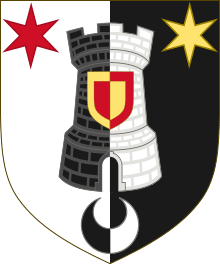 Personal arms | |
| Born | 1661 |
| Died | 2 March 1729 (68 years old) Brussels |
| Nationality | Spanish Netherlands(1661-1714) Austrian Netherlands(1714-1729) |
| Known for | Sculpture, architecture |
Notable work | Statue of James II, Trafalgar Square and many of the Houses of the Grand Place, |
| Style | Baroque[1], classical[2] |
| Spouse(s) | Dorothée de Witte |
| Elected | Guilds of Brussels, Drapery Court, Magistracy of Brussels. |
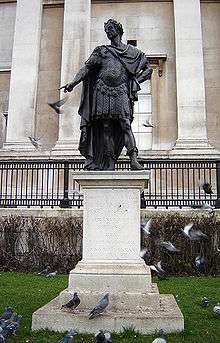
He became famous thanks to his work on a number of the guild houses of the Grand Place[3] which needed to be rebuilt after the bombardment of 1695 and on the Statue of James II[4] in Trafalgar Square, London.[5]
He was the brother of Philippe van Dievoet, goldsmith to Louis XIV and the uncle of the Parisian printer Guillaume Vandive.
Biography
Peter van Dievoet was born into the Van Dievoet family in Brussels and baptised at the Saint Gudula collegiate (now a cathedral) on 29 June 1661.[6] He was born from the second marriage of Gilles van Dievoet, bourgeois of Brussels, to Gertrude Zeevaert. Gilles van Dievoet (? - † before 1672) had a previous marriage with Catherine Slachmeulder, with whom he had among others: Philippe van Dievoet, goldsmith of King Louis XIV.
Peter Van Dievoet was therefore fatherless around the age of twelve or thirteen. His mother later remarried, and died on 22 July 1705.
After some time in Brussels, he moved to England where he was a regular visitor to the studio of Grinling Gibbons. In 1686, he cast and made the statue of James II for St. James's Park in London, now in Trafalgar Square. He returned to Brussels due to the Glorious Revolution of 1688.[4]
In 1695 he was master of the Quatre-Couronnés at Brussels, the guild of stonemasons and sculptors. He was an acclaimed sculptor and was involved in the construction of the new Grand-Place in its baroque style.
He was a member (one of "The Eight") then a judge (or "Dean") of the Drapery Court of Brussels from 1713 to 1723.[7]
Time in London
According to Edmond Marchal, his most important works are in England and are "among the best of that time".[8]
Peter Van Dievoet worked in London in the studio of Quaker sculptor Grinling Gibbons for almost eight years, from 1680 to 1688.
His English production (mainly sculptures) remains poorly known because little research has been done to find and inventory it. George Vertue mentions him only as statuary.[9]
The same George Vertue (1684-1756), who had found an agreement and a receipt of payment for this work, attributes to him, in collaboration with a certain Laurens of Mechelen, the bronze statue of James II (1686) in the courtyard of Whitehall, currently in Trafalgar Square.[10]
Margaret Whinney notes that this statue does not have an English but rather a continental character and gives it the same attribution: two Flemings, Laurens of Mechelen and Dievot of Brussels (sic), were employed to model and make it.[11] This attribution is repeated by Sir Lionel Henri Cust: Dyvoet (sic) ... and Laurens ... who executed the statue of James II at Whitehall.[12]
The fore-mentioned Laurens is identified by Paul-Eugène Claessens as the sculptor Laurence Vander Meulen from Mechlin.
Time in Brussels
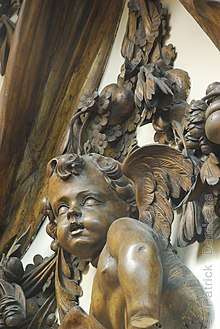
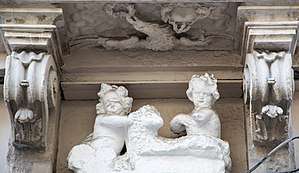
Having returned to his hometown around 1689, Van Dievoet had to meet the requirements of the corporate institution and enrol in the corporation of the Quatre-Couronnés, the Guild of the stonemasons, of which he was officially received as master in 1695. It is at this date that his work in Brussels begins. That same year, Brussels was destroyed by the French bombardment.
Already during his lifetime, Peter Van Dievoet was considered a renowned sculptor.
Long after his death, a report of the magistrates of Brussels to Charles-Alexandre of Lorraine, dated 27 September 1771, quotes Peter Van Dievoet in a list of "very remarkable Brussels sculptors".[13]
From his Brussels work, we still know only of the pieces mentioned by Guillaume Des Marez,[14] while waiting for other "discoveries" or authentications. He is mainly known there for his realisations and conceptions of many of the guild houses of the famous Grand Place.
The following are his work as described by Des Marez.[14]
Wood carving
Peter van Dievoet is also the author of finely chiseled woodcarvings, as shown, for example, by the extremely elaborate lime-wood ornamentation of festoons and fruits, which is preserved at the Royal Museums of Art and History of Brussels.[15]
He also carved out of wood, « keerses » which are richly decorated emblems, used for celebrations, for the tailors' guild.
The House of the White Lamb
The sculptures on the facade of the 1696-built House of the White Lamb (Maison de l'Agneau Blanc) on the Marché aux Herbes are the work of Van Dievoet,
The Grand Place
Van Dievoet sculpted the facades of the following guild halls on the Grand Place: La Maison du Sac (Grand Place, number 4), La Maison du Cornet (number 6), La Maison de l'Arbre d'Or or the House of Brewers (number 10), La Maison de la Chaloupe d'Or (number 24-25).[14]
He was also the architect for Le Heaume (number 34).[14]
 La Maison du Sac
La Maison du Sac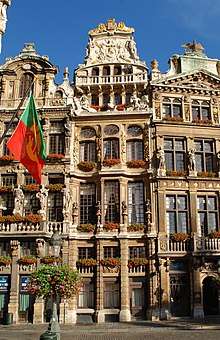 La Maison du Cornet
La Maison du Cornet L'Arbre d'Or
L'Arbre d'Or La Maison de la Chaloupe d'Or
La Maison de la Chaloupe d'Or La Maison du Heaume
La Maison du Heaume
Public functions
Peter continued his career by exercising public functions. From 1713 to 1723, between ages 52 and 62, he was one of The Eight and then Dean (judge) of the Drapery Court,[7] an old Brussels institution that can be compared to a chamber of commerce, and whose members were called the "brothers of the Guild".
At the end of this term, from 1723 to 1724, between ages 62 and 63, he became a member of the magistrate by becoming a Councilor of the City of Brussels.[16] After that, he left public life. A pious man, he had been, until the end of his life, a marguillier (churchwarden) of the Sainte-Gudula collegiate, now a cathedral. He died in Brussels on 2 March 1729, at 68.
Heraldry
 |
|
 Peter's arms from roll of arms of the Drapery Court of Brussels.
Peter's arms from roll of arms of the Drapery Court of Brussels.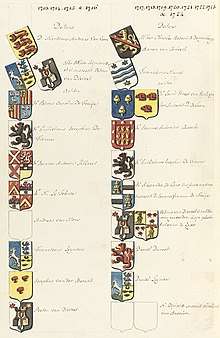 Peter's arms are featured on this roll of arms of the members of the Drapery Court of Brussels.
Peter's arms are featured on this roll of arms of the members of the Drapery Court of Brussels.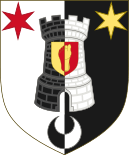 Arms of his brother, Jean-Baptiste, and all members of this family today.
Arms of his brother, Jean-Baptiste, and all members of this family today.
See also
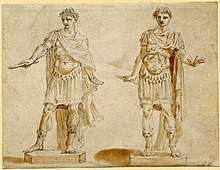


- Brussels school of sculpture
- Drapery Court of Brussels
- Guilds of Brussels
- Bourgeois of Brussels
- Van Dievoet family
Notes and references
- His work in Brussels is Baroque
- The statue of James II is, unusually for the time, in a classical style.
- Éric Hennaut, "Les couleurs de la Grand-Place. Notes sur les parements des façades après le bombardement de 1695", in Autour du bombardement de Bruxelles de 1695. Désastre et relèvement, p. 65, note 11 : "A.G.R., Métiers et Sements de Brabant 286 (corporation des Brasseurs), comptes 1696-1701 ; A.G.R., Notariat Général de Brabant 1987 (notaire P. Van Cutsem), 18 mars 1697, contract for sculpture with Peter van Dievoet : Item sullen de aenbesteder moeten leveren de noodighe avendersteenen tot het maecken van de voors. wercken."
- Horace Walpole, Anecdotes of painting in England: with some account of the principal artists; and incidental notes on other arts; collected by the late Mr. George Vertue ; and now digested and published from his original MSS. by Mr. Horace Walpole, London, 1765, vol. III, p. 91 : "Gibbons had several disciples and workmen; Selden I have mentioned; Watson assisted chiefly at Chatsworth, where the boys and many of the ornaments in the chapel were executed by him. Dievot of Brussels, and Laurens of Mechlin were principal journeymen — Vertue says they modelled and cast the statue I have mentioned in the privy-garden". According to David Green, in Grinling Gibbons, his work as carver and statuary (London, 1964), one Smooke sayd to Vertue that this statue "was modelled and made by Laurence and Devoot [sic]" ; George Vertue, Note Books, ed. Walpole Society, Oxford, 1930-47, vol. I, p.82 : "Lawrence. Dyvoet. statuarys", and ibidem IV, 50 : "Laurens a statuary of Mechlin... Dievot a statuary of Brussels both these artists were in England and assisted Mr. Gibbons in statuary works in K. Charles 2d. and K. James 2d. time, they left England in the troubles of the Revolution and retird to their own country".
- "Artistes, de père en fils". Site-LeVif-FR. 21 November 2008. Retrieved 9 December 2019.
- Brussels, registers of baptisms of Saint Gudula of 29 June 1661 : "29 Junius 1661. Petrus filius legitimus Ægidii Van Dievoet, et Gertrudis Zevart. Suscept : Amplissimus D. Petrus Stockmans Curiae Brab: Consiliarius, et Dlla Maria de Smet".
- Armorial de la Gilde Drapière, Bibliothèque Royale, Cabinet des Manuscrit, ms. G123.
- Edmond Marchal, Mémoire sur la sculpture aux Pays-Bas pendant les xviie et xviiie siècles, Brussels, 1877, pp. 12 et 190.
- Lawrence. Dyvoet. statuarys (Notes Books, 1, 82.), ainsi que : Laurens a statuary of Mechlin... Dievot a statuary of Brussels both these artists were in England and assisted Mr. Gibbons in statuary works in K. Charles 2d. and K. James 2d. time, they left England in the troubles of the Revolution and retird to their own country (ibid. IV, 50).
- Horace Walpole, Anecdotes of painting in England: with some account of the principal artists; and incidental notes on other arts; collected by the late Mr. George Vertue ; and now digested and published from his original MSS. by Mr. Horace Walpole, Londres, 1765, vol. III, p. 91 : « Gibbons had several disciples and workmen; Selden I have men|tioned; Watson assisted chiefly at Chatsworth, where the boys and many of the ornaments in the chapel were executed by him. Dievot of Brussels, and Laurens of Mechlin were principal journeymen — Vertue says they modelled and cast the statue I have mentioned in the privy-garden ». For David Green, in Grinling Gibbons, his work as carver and statuary (Londres, 1964), a certain Smooke assures Vertue that this statue of James II was modelled and made by Laurence and Devoot (sic).
- Margaret Whinney, Sculpture in Britain, 1530 to 1830, London, 1964, p. 55.
- Dictionnary of National Biography, vol. VII, p. 1140.
- Edmond Marchal, La sculpture et les chefs-d'œuvre de l'orfèvrerie belge, Brussels, 1895, p. 583
- Guillaume Des Marez (Illustrated Guide of Brussels, Brussels, 1928).
- Musées royaux d’Art et d’Histoire de Bruxelles, Inventory 614, "encadrement ornemental attribué à Peter van Dievoet" (Brussels, 1661-1729).
- Alexandre Henne and Alphonse Wauters, Histoire de la ville de Bruxelles, Éditions culture et civilisation Bruxelles, 1975, Volume 2, pp. 507-508
- "drawing". British Museum. Retrieved 29 December 2019.
- Katherine Gibson, 'The emergence of Grinling Gibbons as a statuary', published in Apollo, September 1999, p. 28.
Further reading
- — « La généalogie et l'héraldique au service de l'histoire de l'art », in L'Intermédiaire des généalogistes, n° 137, Brussels, 1968.
- — « Généalogie de Brou (x) », in L'Intermédiaire des généalogistes, n° 122, Brussels, 1966, p. 88.
- — La Grand'Place de Bruxelles, illustrations de Van Gucht, Brussels, galerie Ex-Libris, s.d., n° 10.
- Philippe Baert, Mémoires sur les sculpteurs et architectes des Pays-Bas, edited by Baron de Reiffenberg, Brussels, 1848, p. 117.
- Bénézit, Dictionnaire critique et documentaire des peintres, sculpteurs, dessinateurs et graveurs, Paris, 1955, vol. 3, p. 268 et ibid. Paris, 1956, vol. 4, p. 238.
- Bénézit, Dictionary of Artists, 2006, vol.4, p. 911.
- Edwin Beresford Chancellor, The Romance of Soho. Being an Account of the District, Its Past Distinguished Inhabitants, 1931, p. 32.
- David Blayney Brown, Catalogue of the Collection of Drawings in the Ashmolean Museum, Ashmolean Museum - Art, 1982, p. 637.
- Andrée Brunard, "La Grand-Place, joyau de la Capitale", in, Les Belles Heures de Bruxelles, Paris-Bruxelles, 1952, p. 170.
- J. E. Buschman, Annales de l'Académie d'archéologie de Belgique, Bruxelles, 1867, p. 486 et p. 507.
- Paul-Eugène Claessens et Julien Cuypers, "Quand Bruxelles ravagée renaît plus belle sous les ailes de l'archange : le sculpteur Pierre van Dievoet, son œuvre et sa famille", in Intermédiaire des généalogistes, no. 121, Brussels, 1966, pp. 39–41.
- Maurice Culot, Eric Hennaut, Marie Demanet, Caroline Mierop, Le bombardement de Bruxelles par Louis XIV et la reconstruction qui s'en suivit 1695-1700, Brussels, 1992, p. 218 (Contrat d'adjudication de la maison du Cornet, Grand-Place)
- Allan Cunningham, The Lives of the Most Eminent British Painters and Sculptors, vol III, New York, 1835, p. 14.
- Sir Lionel Henri Cust, "Grinling Gibbons", Dictionary of National Biography, London, 1949–56, vol. VII, p. 1140.
- M. J. De Decker, "Relevé de l'Agneau Blanc", (deuxième prix partagé, S.C.A.B. concours annuel de relevés de 1924), dans, L'Émulation, Brussels, 1925, plate 8.
- Guillaume Des Marez, Guide illustré de Bruxelles, Brussels, 1928, vol. 1, pp. 65, 81, 82, 89, 90, 92, 112, and vol. 11, p. 182.
- Guillaume Des Marez, "Les transformations de la ville de Bruxelles au XVIIème siècle et les métiers de la construction", Études inédites, Brussels, 1936, p. 135.
- Pieter D'Hondt, L'académie royale, notice historique, Brussels, s.d., p. 21.
- George Godwin, John Britton, The Churches of London: A History and Description of the Ecclesiastical Edifices of the Metropolis, 1839.
- David Green, Grinling Gibbons his work as carver and statuary, 1648-1721, Londres, 1964, pp. 56, 194.
- Great men of Great Britain, Cyclopaedia, Great Britain, 1866, p. 109.
- Rupert Gunnis, Dictionary of British Sculptors 1660–1851, London, 1953, pp. 130, 169, 406.
- Alexandre Henne et Alphonse Wauters, Histoire de la ville de Bruxelles, Bruxelles, 1845, vol. II, p. 556 ; Mina Martens, Index général, Brussels, 1972, s.v. "Dievoet".
- Mary Botham Howitt, Howitt's Journal of Literature and Popular Progress, William Howitt, 1847, p. 408.
- Johannes Immerzeel, De levens en werken der Hollandsche en Vlaamsche kunstschilders, beeldhouvers, graveurs, Amsterdam, 1842, p. 278.
- Chevalier Edmond Marchal, Mémoire sur la Sculpture aux Pays-Bas pendant les XVII et XVIII siècles, Brussels, 1877, pp. 3, 12, 82, 190; La sculpture et les chefs-d'œuvre de l'orfèvrerie belges, Brussels, 1895, pp. 468, 5S3, 743.
- Dr. Kurt Zoege von Manteuffel, "Dievoet (Dievot), van Bildhauer in Brüssel", in Ulrich Thieme and Felix Becker (eds.), Allgemeines Lexicon des bildenden Künstler von der Antike bis zur gegenwart, Leipzig, 1913, vol. IX, p. 279.
- Victor-Gaston Martiny, "Le décor architectural de la Grand-Place", La Grand-Place de Bruxelles, Brussels and Liège, 1966, p. 122.
- André Monteyne, De Brusselaars in een stad die anders is, 1981, pp. 127, 367.
- Dr. Georg Kaspar Nagler, Neues Allgemeines Künstler- Lexicon, Munich, 1836, vol. III, p. 404.
- Henry-Charles van Parys, "Van Dievoet : réponse", L'Intermédiaire des généalogistes, no. 148, Brussels, 1970, p. 254.
- Alexandre Pinchart, Archives des arts, sciences et lettres, documents inédits, Gand, 1860, vol. I, p. 40.
- L. G. G. Ramsey, The Concise Encyclopedia of Antiques, The Connoisseur, London, 1901, p. 155.
- Viviane Roothooft, De Grote Markt te Brussel, Bruxelles, 1978, p. 13.
- Georges Sion, Bruxelles ou les contes de Mille et un ans, Bruxelles, 1979, pp. 170 et 174.
- Félix Stappaerts, "Pierre van Dievoet", Biographie Nationale de Belgique, Brussels, 1878, vol. VI, column 74; Brussels, 1936–1938, vol. XXVI, column 385.
- H. Avray Tipping, Grinling Gibbons and the Wood-work of his age (1648-1720), London, 1914, pp. 95, 125, 251.
- Alain Van Dievoet, "Les Vandive, consuls de Paris", L'Intermédiaire des généalogistes, no. 180, Brussels, 1975, pp. 452 à 453.
- Alain Van Dievoet, Une famille d'orfèvres et consuls de Paris d'origine bruxelloise : les van Dievoet dits van Dive, Bruxelles, 1976, passim (xérocopié).
- Alain Van Dievoet, "Question sur le sculpteur Pierre van Dievoet", L'Intermédiaire des généalogistes, no. 147, Brussels, 1970, p. 185.
- Alain Van Dievoet, "Un disciple belge de Grinling Gibbons, le sculpteur Pierre van Dievoet (1661-1729) et son œuvre à Londres et Bruxelles", Le Folklore brabançon, March 1980, no. 225, pp. 65-91.
- Alain Van Dievoet, "Généalogie de la famille van Dievoet originaire de Bruxelles, dite van Dive à Paris", Le Parchemin, Brussels, 1986, no. 245, pp. 273-293.
- Alain Van Dievoet, "Quand le savoir-faire des orfèvres bruxellois brillait à Versailles", Cahiers bruxellois, Brussels, 2004, pp. 19-66.
- Marcel Vanhamme, Bruxelles. Promenades dans le Passé, Brussels, 1949, pp. 76, 84.
- Louis Verniers, Un millénaire d'histoire de Bruxelles depuis les origines jusqu'en 1830, Brussels, 1965, pp. 364, 366, 644.
- George Vertue, Note Books, ed. Walpole Society, Oxford, 1930–47, vol. I, pp. 61, 82, 106; vol. IV, p. 50.
- George Vertue and Horace Walpole, Anecdotes of Painting in England, London, 1765, vol. III, p. 91.
- Alphonse Wauters, Liste des doyens des corps de métier de Bruxelles 1696-1795, Brussels, 1888, p. 55.
- Margaret Whinney, Sculpture in Britain, 1530 to 1830, London, 1964, p. 55.
- Dr. Alfred von Wurzbach, Niederländischer Künstler-Lexicon, Vienna and Leipzig, 1906, vol. I, p. 407.
External links
- The genealogy of the family of sculptor Peter Van Dievoet
- Van Dievoet, Pierre on the website of the British Museum
- Studies for a statue of a figure in Roman dress on the website of the British Museum